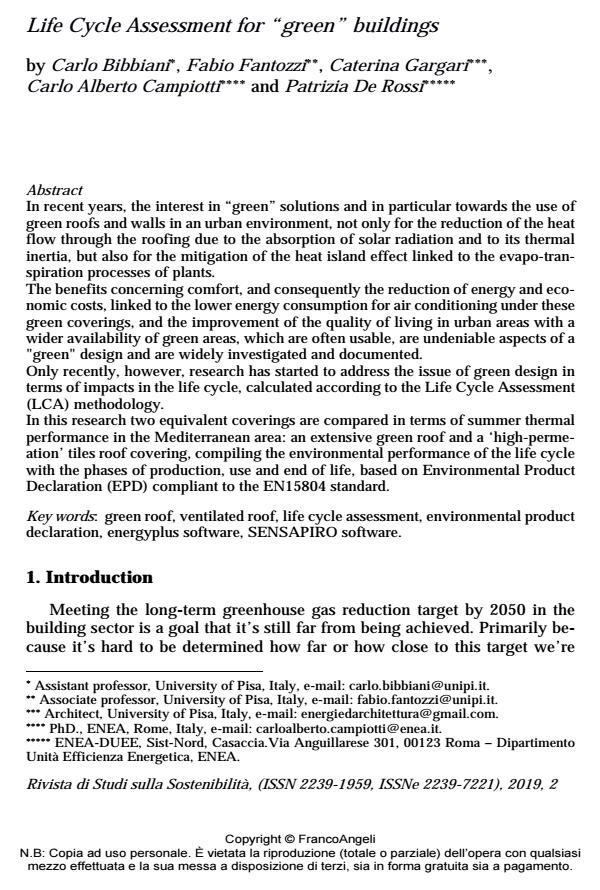Life Cycle Assessment for "green" buildings
Titolo Rivista RIVISTA DI STUDI SULLA SOSTENIBILITA'
Autori/Curatori Carlo Bibbiani, Fabio Fantozzi, Caterina Gargari, Carlo Alberto Campiotti, Patrizia De Rossi
Anno di pubblicazione 2020 Fascicolo 2019/2 Suppl. Lingua Inglese
Numero pagine 17 P. 195-211 Dimensione file 199 KB
DOI 10.3280/RISS2019-002-S1013
Il DOI è il codice a barre della proprietà intellettuale: per saperne di più
clicca qui
Qui sotto puoi vedere in anteprima la prima pagina di questo articolo.
Se questo articolo ti interessa, lo puoi acquistare (e scaricare in formato pdf) seguendo le facili indicazioni per acquistare il download credit. Acquista Download Credits per scaricare questo Articolo in formato PDF

FrancoAngeli è membro della Publishers International Linking Association, Inc (PILA)associazione indipendente e non profit per facilitare (attraverso i servizi tecnologici implementati da CrossRef.org) l’accesso degli studiosi ai contenuti digitali nelle pubblicazioni professionali e scientifiche
In recent years, the interest in "green" solutions and in particular towards the use of green roofs and walls in an urban environment, not only for the reduction of the heat flow through the roofing due to the absorption of solar radiation and to its thermal inertia, but also for the mitigation of the heat island effect linked to the evapo-transpiration processes of plants. The benefits concerning comfort, and consequently the reduction of energy and economic costs, linked to the lower energy consumption for air conditioning under these green coverings, and the improvement of the quality of living in urban areas with a wider availability of green areas, which are often usable, are undeniable aspects of a "green" design and are widely investigated and documented. Only recently, however, research has started to address the issue of green design in terms of impacts in the life cycle, calculated according to the Life Cycle Assessment (LCA) methodology. In this research two equivalent coverings are compared in terms of summer thermal performance in the Mediterranean area: an extensive green roof and a ‘high-permeation’ tiles roof covering, compiling the environmental performance of the life cycle with the phases of production, use and end of life, based on Environmental Product Declaration (EPD) compliant to the EN15804 standard.
Keywords:Green roof, ventilated roof, life cycle assessment, environmental product declaration, energyplus software, SENSAPIRO software.
- Beccali M., Cellura M., Fontana M., Longo S., Mistretta M. (2013). Energy retrofit of a single-family house: Life cycle net energy saving and environmental benefits. Renewable and Sustainable Energy Reviews, 27: 283-293.
- Bibbiani C., Fantozzi F., Gargari C. (2016). Modelli di LCA per sostenibilità energetica e ambientale di coperture e/o pareti verdi di edifici. ENEA, Report Ricerca di Sistema Elettrico, RdS/PAR2015/154.
- Boermans T., Bettgenhäuser K., Offermann M., Schimschar S. (2012). Renovation tracks for Europe up to 2050. Building renovation in Europe – what are the choices? Report by order of the European insulation Manufacturers Association (EURIMA). Cologne, ECOFYS (Ed.), Germany.
- Chenani S.B., Lehvävirta S., Häkkinen T. (2015). Life cycle assessment of layers of green roofs. Journal of Cleaner Production, 90: 153-162.
- Gargari C., Bibbiani C., Fantozzi F., Campiotti. C.A. (2016). Environmental impact of Green roofing: the contribute of a green roof to the sustainable use of natural resources in a life cycle approach. Agriculture and Agricultural Science Procedia, 8: 646-656.
- Gargari C., Bibbiani C., Fantozzi F., Campiotti. C.A. (2016). Simulation of the thermal behaviour of a building retrofitted with a green roof: optimization of energy efficiency with reference to Italian climatic zones. Agriculture and Agricultural Science Procedia, 8: 628-636.
- IPCC (2015). Climate Change 2014: Mitigation of Climate Change, Working Group III Contribution to the Fifth Assessment Report of the Intergovernmental Panel on Climate Change IPCC Fifth Assessment Report.
- Kosareo L., Ries R. (2007). Comparative environmental life cycle assessment of green roofs. Building and Environment, 42(7): 2606-2613.
- KNAUF Soutions guide www.knaufinsulation.co.uk Kuramochi T., Höhne N., Schaeffer M., Cantzler J., Hare B., Deng Y., Sterl S.,
- Hagemann M., Rocha M., Yanguas-Parra P.A., Goher-Ur-Rehman M., Wong L., El-Laboudy T., Wouters K., Deryng D., Blok K. (2018). Ten key short-term sectoral benchmarks to limit warming to 1.5°C. Climate Policy, 18(3): 287-305. DOI: 10.1080/14693062.2017.1397495
- Morau D., Rabarison T.N., Rakotondramiarana H. T. (2017). Life Cycle Analysis of Green Roof Implemented in a Global South Low-Income Country. British Journal of Environment & Climate Change, 7(1): 43-55. Rogelj J., Luderer G., Pietzcker R.C., Kriegler E., Schaeffer M., Krey V., Riahi K. (2015). Energy system transformations for limiting end-of-century warming to below 1.5°C. Nature Climate Change, 5(6): 519-527.
- Saiz S., Kennedy C., Bass B., Pressnail, K. (2006). Comparative Life Cycle Assessment of Standard and Green Roofs. Environmental Science and Technology, 40: 4312-4316.
- SENSAPIRO (2019), www.lifeherotile.eu
- UNFCCC (2015). Adoption of the Paris Agreement. Proposal by the President.Draft decision -/CP.21. Conference of the Parties. Twentyfirst session, Paris, 30 November to 11 December 2015. FCCC/CP/2015/L.9. United Nations Framework Convention on Climate Change.
- URBANSCAPE (2016). Extensive Green Roof System. EPD-KNI-20160071-CBA1-EN.
Carlo Bibbiani, Fabio Fantozzi, Caterina Gargari, Carlo Alberto Campiotti, Patrizia De Rossi, Life Cycle Assessment for "green" buildings in "RIVISTA DI STUDI SULLA SOSTENIBILITA'" 2 Suppl./2019, pp 195-211, DOI: 10.3280/RISS2019-002-S1013